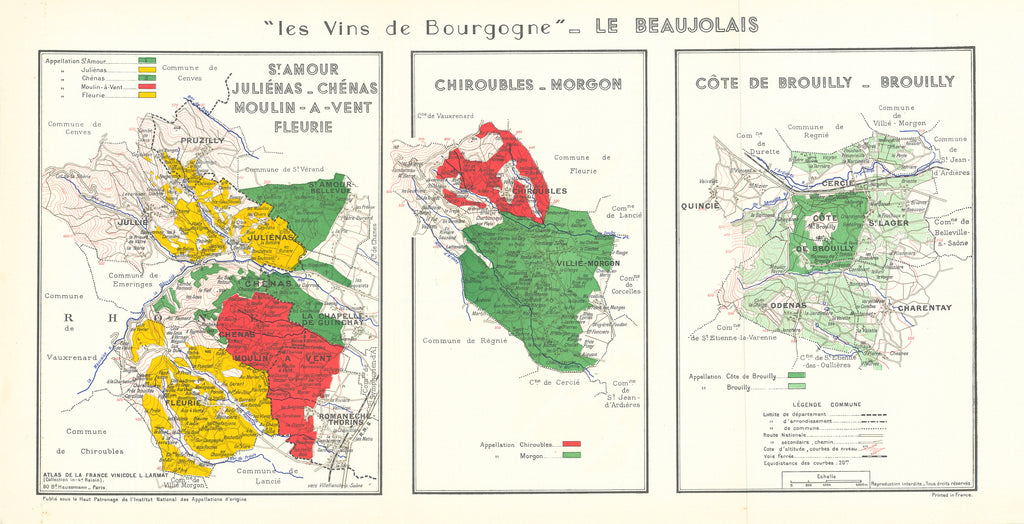- Title: Les Vins de Bourgogne - Le Beaujolais St. Amour et al
- Author: Louis Larmat
- Date: 1953
- Condition: Very good - some marginal staining at left, issued folds
- Inches: 21 x 10 3/4 [Image]
- Centimeters: 53.34 x 27.31 [Image]
- Product ID: 308243
Fine Larmat Wine Map of Beaujolais
Map of one of the principal wine growing regions in France from Les Vins De Bourgogne. Maps from this publication, as here, show in detail appellations controllées (AOC) with colors indicating the designation of the classification of wine by terroir. Indicates communes/villages, individual vineyards/vignobles are named and delineated, including the appellations of St Amour, Juliénas, Chénas, Moulin-à-Vent, Fleurie, Chiroubles, Morgon, Côte de Brouilly & Brouilly. The map is lovely and quite detailed, showing rivers, canals, forests, towns, villages, roads, and chateau. Elevation on the detailed maps in hachure.
The Beaujolais is a historical province and a wine-producing region in central eastern France, located north of Lyon and south of Macon and covering parts of the north of the Rhône department (Rhône-Alpes) and parts of the south of the Saône-et-Loire department (Burgundy). Administratively the Beaujolais is in the Rhone but as a wine region, parts of it fall under Burgundy in Saone and Loire.
From Rome to France, Burgundy Wine History
The Romans planted the first vineyards in the Beaujolais around Mount Brouilly. In the late 14th century, when the Duke of Burgundy decided to focus on planting the Pinot Noir grape variety, the Beaujolais in the south opted to plant only Gamay vines for its wine production. The Gamay grape variety, being hardier, ripening earlier and producing a stronger fruitier wine than Pinot Noir, hence creating a distinctive difference between the two regions. Today, 98% of the Beaujolais is planted with Gamay, the rest being mainly planted with Chardonnay to produce still and sparkling white wines.
The Different Wines
Beaujolais wines from the south are considered to be generally light and fruity with a floral aroma, making it easy to drink as an aperitif or accompanying a summer meal – these are known simply as ‘Beaujolais’. Some producers opt for also producing a Beaujolais Nouveau, which is precocious wine, extra light with a short maturation period, which comes on to the market at midnight on the third Thursday in November, to be drunk during the closing months of the year. The wines produced just north of the center are known as ‘Beaujolais Villages’ and come from 39 villages and their surrounding areas. These wines are more complex than a ‘Beaujolais’ and can have a much deeper color and flavor, most notably those of red and black fruits and berries with more subtle mineral notes, a wine that most typically develops over a three year period. The vineyard at Chez Briar and Michel is situated in the Beaujolais Villages area and neighbors with Brouilly. The 10 Crus are situated in the most northern part of the Beaujolais - each produced in a village or area which has its own wine characteristics and produces a wine that carries that name - Brouilly, Côte de Brouilly, Régnié, Morgon, Chiroubles, Chenas, Fleurie, Moulin-à-Vent, Juliènas, Saint-Amour. These wines are the most complex of the Beaujolais region and generally contain more tannins which gives them a longer maturation period of around five years in which to develop depth and a broader array of rich flavors and aromas.
It is safe to presume that as long as wine is consumed, the visual story of wine growing will continue to have great appeal.
Reference: Vins de Bourgogne, Bourgogne-wines.com


